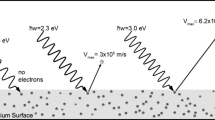Abstract
By analyzing the Dirac equation with static electric and magnetic fields it is shown that Dirac’s theory is nothing but a generalized one-particle quantum theory compatible with the special theory of relativity. This equation describes a quantum dynamics of a single relativistic fermion, and its solution is reduced to solution of the generalized Pauli equation for two quasiparticles which move in the Euclidean space with their effective masses holding information about the Lorentzian symmetry of the four-dimensional space-time. We reveal the correspondence between the Dirac bispinor and Pauli spinor (two-component wave function), and show that all four components of the Dirac bispinor correspond to a fermion (or all of them correspond to its antiparticle). Mixing the particle and antiparticle states is prohibited. On this basis we discuss the paradoxical phenomena of Zitterbewegung and the Klein tunneling.
Similar content being viewed by others
References
Barut, A.O.: Combining relativity and quantum mechanics: Schrödinger’s interpretation of \(\psi \). Found. Phys. 18, 95–105 (1988)
Holland, P., Brown, H.R.: The non-relativistic limits of the Maxwell and Dirac equations: the role of Galilean and gauge invariance. Stud. Hist. Philos. Mod. Phys. 34, 161–187 (2003)
Messiah, A.: Quantum Mechanics, vol. 2. North-Holland Publishing Company, Amsterdam (1965)
Hansen, A., Ravndal, F.: Klein’s Paradox and its resolution. Phys. Scr. 23, 1036–1042 (1981)
Holstein, B.R.: Klein’s paradox. Am. J. Phys. 66, 507–512 (1998). doi:10.1119/1.18891
Calogeracos, A., Dombey, N.: History and physics of the Klein paradox. Contemp. Phys. 40(5), 313–321 (1999)
Bosanac, S.D.: Solution of Dirac equation for a step potential and the Klein paradox. J. Phys. A 40, 8991–9001 (2007)
Kononets, Y.V.: Charge conservation, Klein’s paradox and the concept of paulions in the Dirac electron theory. New results for the dirac equation in external fields. Found. Phys. 40, 545–572 (2010). doi:10.1007/s10701-010-9414-6
Alhaidari, A.D.: Resolution of the Klein paradox. Phys. Scr. 83, 025001 (4pp) (2011)
Payandeh. F., Pur, T.M., Fathi, M. and Moghaddam, Z.Gh.: A Krein quantization approach to Klein paradox. ar**v:1305.1927v3 [gr-qc]
Gerritsma, R., Kirchmair, G., Zahringer, F., Solano, E., Blatt, R., Roos, C.F.: Quantum simulation of the Dirac equation. Nature 463, 68–71 (2010)
O’Connel, R.F.: Zitterbewegung is not an observable. Mod. Phys. Lett. A 26(7), 469–471 (2011)
Schroedinger, E.: Über die kräftfreie bewegung in der relativistischen quantenmechanik. Sitz. Preuss. Akad. Wiss. Phys.-Math. Kl. 24, 418 (1930)
Hestenes, D.: Zitterbewegung in quantum mechanics. Found. Phys. 40(1), 1–54 (2010)
Greiner, W.: Relativistic Quantum Mechanics: Wave Equations. Springer, Berlin (1994)
Bjorken, J.D., Drell, S.D.: Relativistic Quantum Mechanics. McGraw-Hill, New York (1964)
Beenakker, W.J.: Colloquium: Andreev reflection and Klein tunneling in graphene. Rev. Mod. Phys. 80, 1337–1354 (2008)
Burt, M.G.: The justification for applying the effective-mass approximation to microstructures. J. Phys. Condens. Matter 4, 6651–6690 (1992)
Karavaev, G.F., Krivorotov, I.N.: A method of envelo** functions for description of electron states in microstructures with smooth variation of the potential at heterointerfaces. Phys. Tech. Semicond. 30(1), 177–187 (1996)
Dodonov, V.V.: Strict lower bound for the spatial spreading of a relativistic particle. Phys. Lett. A 171, 394–398 (1993)
Unanyan, R.G., Otterbach, J., Fleischhauer, M.: Confinement limit of Dirac particles in scalar one-dimensional potentials. Phys. Rev. A 79, 044101 (2009)
Cheng, J.-Y.: A complete proof of the confinement limit of one-dimensional Dirac particles. Found. Phys. 44, 953–959 (2014)
Zawadzki, W.: One-dimensional semirelativity for electrons in carbon nanotubes. Phys. Rev. B 74, 205439 (1–4) (2006)
Cserti, J., Dávid, G.: Unified description of Zitterbewegung for spintronic, graphene, and superconducting systems. Phys. Rev. B 74, 172305(1–4) (2006)
Zarenia, M., Chaves, A., Farias, G.A., Peeters, F.M.: Energy levels of triangular and hexagonal graphene quantum dots: a comparative study between the tight-binding and Dirac equation approach. Phys. Rev. B 84, 245403(1–12) (2011)
Acknowledgments
First of all I would like to thank Prof. I. L. Buchbinder for his useful critical remarks on the first version of the paper. I also thank Prof. V. G. Bagrov, Prof. V. A. Bordovitsyn and Prof. G. F. Karavaev for useful discussions on this subject. Finally, I want to express my deep gratitude to Reviewers for their helpful remarks and questions. This work was supported in part by the Programm of supporting the leading scientific schools of RF (Grant No 88.2014.2) for partial support of this work.
Author information
Authors and Affiliations
Corresponding author
Rights and permissions
About this article
Cite this article
Chuprikov, N.L. The Stationary Dirac Equation as a Generalized Pauli Equation for Two Quasiparticles. Found Phys 45, 644–656 (2015). https://doi.org/10.1007/s10701-015-9888-3
Received:
Accepted:
Published:
Issue Date:
DOI: https://doi.org/10.1007/s10701-015-9888-3




